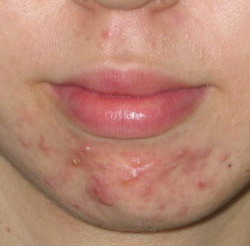Cystic acne, or sometimes known as nodulocystic acne, is one of the most severe forms of acne vulgaris. One word of advice, as soon as you are aware of it happening to you, visit your dermatologist immediately as it may adversely affect your skin in the long run if untreated. Any delays in doing will increase your chances of getting permanent acne scars, since this form of acne is much more severe than other forms of acne. Here in this piece, I review the most common cystic acne treatments administered, highlighting their plus and minus points. Before looking at these treatments however, it is useful to first understand the nature and characteristics of cystic acne.

When you have inflamed, deep blushes breaking out over parts of your body like your face, shoulder and back that could be a good indication that you might have cystic acne. Before you become unnecessarily alarmed at these signs however, know that the term cystic acne is only rightfully used when you develop cysts as part of your acne. So what are cysts? Well they’re basically bumps or blemishes in your skin that feel soft and are fluid-filled. Normally the same size as normal pimples, these cysts should not be burst so as to avoid cross infection. People suffering from cystic acne may find they also have nodules on their facial skin. Nodules are nothing more than bumps slightly larger than cysts, but are hard and can be painful to the touch. Even with professional help, it is useful to note that these have a long recovery time because these develop from deep within the skin structure.
From observations made of cystic acne, it appears that it is more prevalent among people with a family history of the condition. Demographically speaking, men below the age of 35 and teenagers going through puberty are more likely to suffer from cystic acne. You may think that cystic acne is caused when you have poor facial cleansing habits or a poor diet, however that is not the case. The truth is these are likely not to be contributing factors. As explained earlier however, it does seem that genetic predisposition is one of the primary causes for this severe form of acne.
The next section gives details on treatments for cystic acne available. The first thing to mention is that I highly recommend you consult a dermatologist without delay to profile your skin condition because cystic acne can quickly increase in severity. Below I have described particulars of available treatment, highlighting each one’s plus and minus points. Here are the 5 most common treatments for cystic acne:-
a) Oral antibiotics
The most common form you find these in is orally ingested pills. Your dermatologist will usually prescribe them in 3 monthly batches. Ensure you finish whatever amount of pills is given, as you do not want the bacteria to develop immunity against the antibiotics. The antibiotic works by slowly killing off P-acne population on your skin which in turn controls the infection. As long as you have no known antibiotic allergies, this treatment should work well enough. The plus point for this treatment is that it is generally quite affordable. A downside is that a small number of users find they experience nausea and possibly some stomach discomfort.
b) Isotretinoin
You may know these from their more common brand names such as Claravis, RoAccutane, Amnesteem or even Isotane. These are also normally available in tablet form but cost more per course of treatment compared to antibiotics. These drugs give better results in treating cystic acne because they work through several different mechanisms. One mechanism they use is to reduce the amount of sebum produced by your sebum glands by way of making the gland opening smaller.
One other way it works is by reducing the size of P-acne bacteria colonies, since it possesses antimicrobial properties. One negative effect of this treatment however, is the more noticeable side effects. People who use isotretinoin find that their eyes, skin and lips are quite dry throughout the treatment period. Additionally, they may experience flare up of acne breakouts and occasional skin flaking. On the balance however, few other cystic acne treatments work as well as this one.
c) Oral contraceptives (for women)
This course of treatment should only be considered if you were thinking of using oral contraceptives regardless, and not as the primary acne control method. Essentially, this method works by controlling your sebum secretion levels, and this is achieved by reducing overall testosterone production levels. Be warned however, because some types of contraceptives may actually increase your level of testosterone, depending on their mechanisms of action. Needless to say, these may actually cause your acne to become worse. When seeking advice from a pharmacist, be honest about the secondary reason you’re using contraceptives and they should prescribe the appropriate forms.
d) Surgical excision and drainage
Surgical excision and drainage is a cosmetic procedure that does not target the previously mentioned mechanisms of acne. Due to the level of risks involved, it is generally not recommended unless your symptoms are deemed to be quite severe. In the procedure, the surgeon drains intra-cavity fluids from your blemishes by applying tiny incisions along facial lesions. Many who have gone through this procedure marvel at the results they can see, but one consideration to take is that this procedure can be fairly expensive.
e) Intralesional injections
This method works by reducing the inflammation and size of lesions via an injection into your dermis layer. One added advantage this method has is that it has been found to reduce permanent acne scarring. On the plus side, you may see considerable improvement in your skin within a week or so, but the negative is that the procedure may be fairly painful and there may be considerable monetary costs involved.
